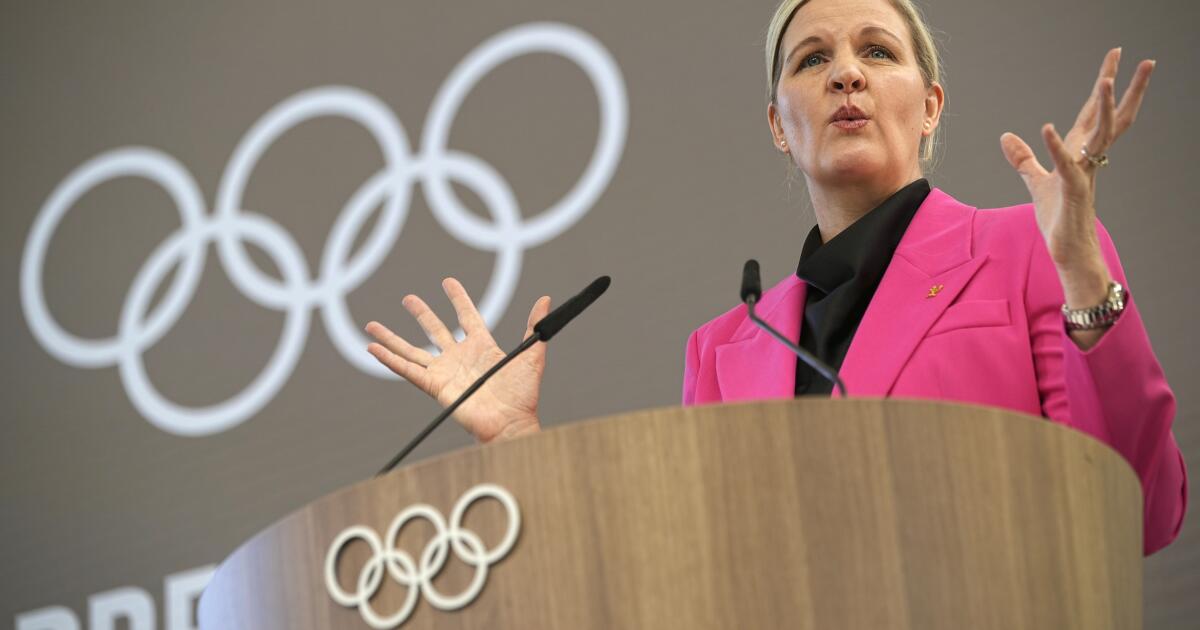IOC inches toward ban on transgender athletes competing as women
The International Olympic Committee pumped the brakes on a report Monday that the body was poised to ban athletes born male from competing in women’s Olympic events, saying that “no decisions have been taken yet.”
A report in The Times of London stated that the ban on transgender women in female competition would be implemented early in 2026 “after a science-based review of evidence about permanent physical advantages of being born male.”
The IOC insisted the report was premature but did not refute that a new policy was forthcoming.
A spokesperson confirmed that medical and scientific director Dr. Jane Thornton updated IOC members last week at a meeting in Lausanne, Switzerland, on the initial findings of a working group studying the issue. However, the spokesperson said in a statement that “the working group is continuing its discussions on this topic and no decisions have been taken yet. Further information will be provided in due course.”
New IOC president Kirsty Coventry succeeded Thomas Bach in June and three months later formed the Protection of the Female Category working group made up of experts as well as representatives of international federation to study the issue.
The findings and a new policy could be announced as soon as the IOC session, scheduled in February ahead of the Milan-Cortina Winter Olympics.
Under Bach, the IOC declined to apply a universal rule on transgender participation in the Olympics, and transgender athletes remain eligible to participate. Each sport’s international federation is allowed to set its own rules.
However, Coventry said in her first news conference after becoming IOC president that she believes Olympic sports should do away with the current piecemeal approach to setting rules on transgender inclusion and instead implement a policy that applies to most or all sports.
“We understand that there will be differences depending on the sport,” she said. “But it was very clear from the members that we have to protect the female category, first and foremost to ensure fairness.
“We have to do it with a scientific approach and with the inclusion of the international federations who have done a lot of work in that area.”
President Trump signed an executive order early this year banning transgender athletes from competing in women’s sports in U.S. schools and said he intends to apply the policy at the Los Angeles Olympics in 2028. The order directs the Secretary of State to attempt to change IOC rules on transgender participation and also directs immigration officials to refuse admission to transgender women from other countries for the purposes of sports participation.
California Department of Education officials refused to comply with the order. However, Trump’s announcement prompted the U.S Olympic and Paralympic Committee to change their rules and ban transgender athletes from taking part in women’s sports.
The most recent Olympics controversy over gender eligibility occurred at the Paris Games last summer when boxer Imane Khelif of Algeria won the women’s welterweight gold medal a year after being disqualified from the World Championships for reportedly failing a gender eligibility test.
The IOC allowed Khelif and Taiwan’s Lin Yu-ting to compete in the women’s division because their passports identified them as female. Yu-ting had been banned by the suspended International Boxing Assn. (IBA).
In an attempt to identify athletes raised as female but who sometimes carry physical advantages of males — called Differences of Sexual Development (DSD) — international boxing this year introduced mandatory tests for athletes in the female category to detect a gene on the Y chromosome that triggers the development of male characteristics.
Other sports have created a range of thresholds to ban or allow transgender athletes to compete as women. World Athletics, the international governing body for track and field, bans transgender athletes who have undergone male puberty. World Rugby forbids transgender athletes from competing at the highest level. And World Aquatics allows transgender athletes who transitioned before the age of 12 to compete as women.
Very few transgender athletes have taken part in the Games. New Zealand weightlifter Laurel Hubbard became the first openly transgender athlete to compete in a different gender category in the 2021 Tokyo Olympics.
“I don’t think we need to redo all the work that’s been done — we can learn from the international federations and set up a task force that will look at this constantly and consistently,” Coventry said. “The overarching principle must be to protect the female category.”
